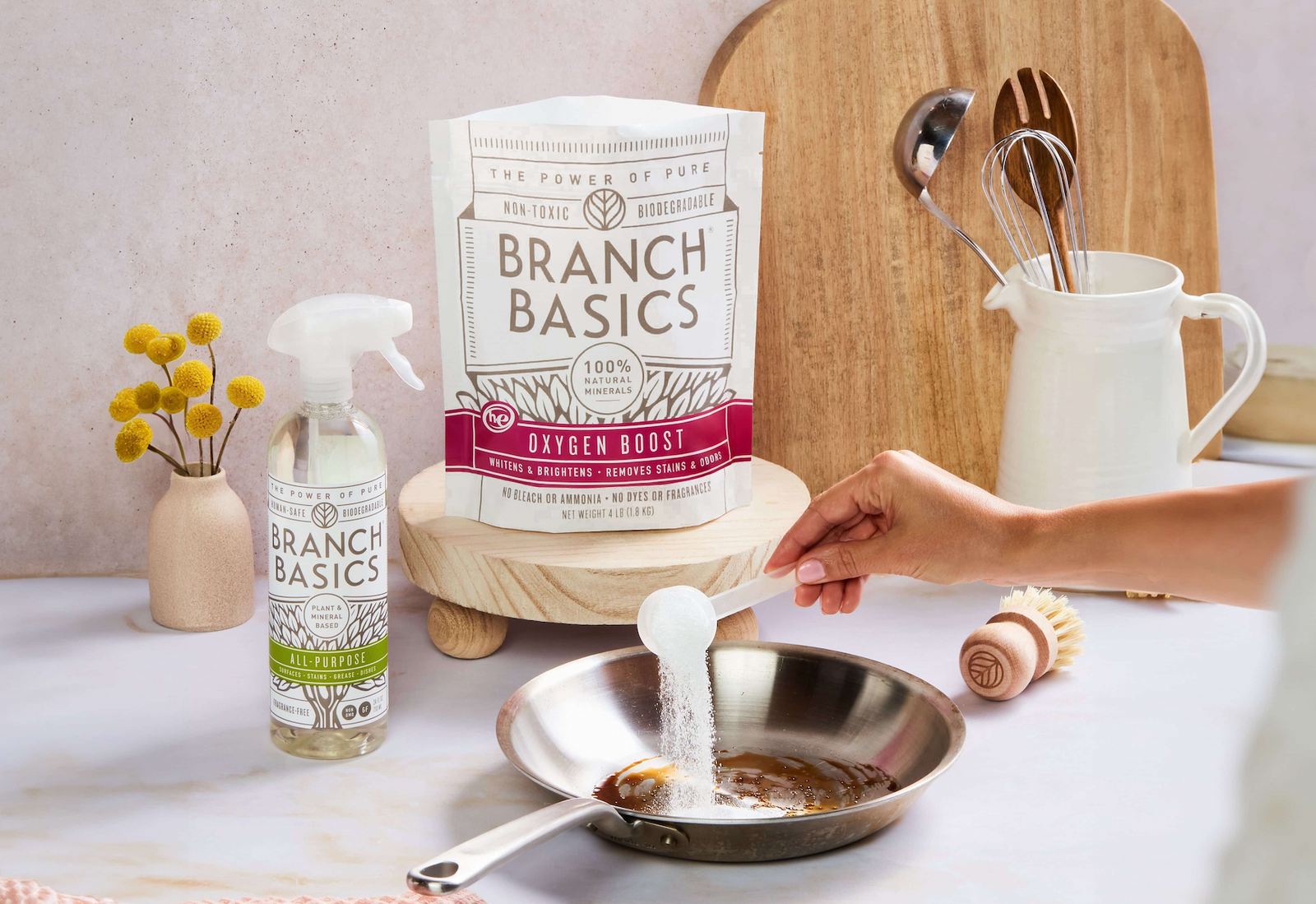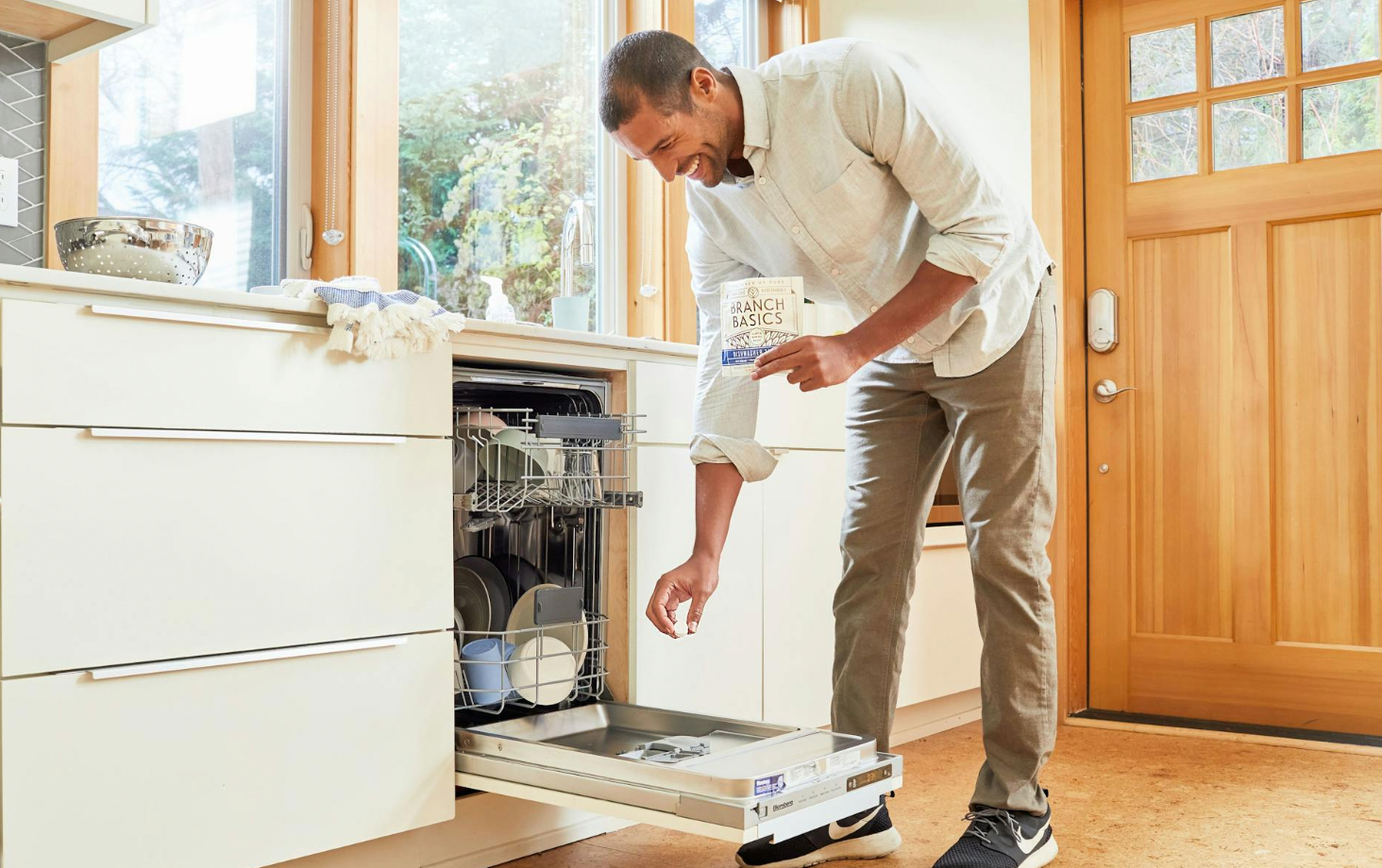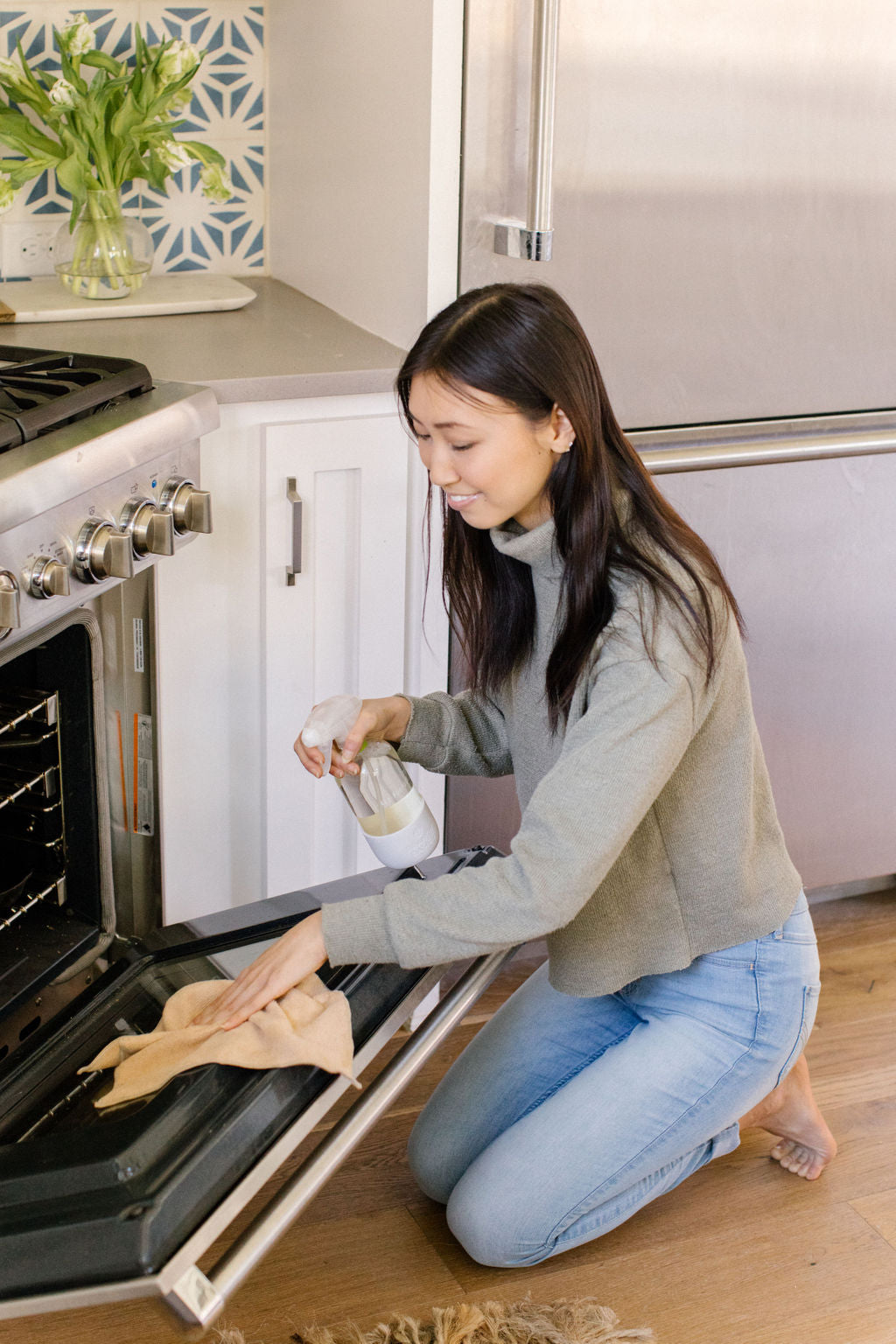How to Clean Stainless Steel Pots & Pans Naturally: 3 Methods

Stainless steel pots and pans are versatile, affordable, and typically a safe option for healthy cooking.
One of the only downsides is food often gets stuck during cooking.
Although this is preferable to exposing yourself to PFAS from non-stick cookware, cleaning pots and pans naturally can be challenging without the know-how.
That’s what this article is all about: how to clean stainless steel pots and pans naturally.
Whether you’ve burnt the bottom of your pan or your pot is a sticky mess, these tips will help you tackle any mess and restore your cookware to like-new condition.
Materials Needed
Cleaning your stainless steel pots and pans doesn’t require any fancy materials.
In this article, we’ll share three methods to clean up burnt-on or cooked-on messes using either:
- Branch Basics
- Baking Soda
- Vinegar
What you'll need:
- Branch Basics All-Purpose Spray + Oxygen Boost (if using Branch Basics)
- OR Baking soda
- OR Vinegar
- Scrubbing Brush
The exact materials you need depend on the method you choose. Let’s explore those now.
How To Clean Stainless Steel Pots & Pans With Branch Basics
Branch Basics is well-known as an all-in-one, safe, and natural cleaning system designed to replace every cleaning product in your home with just one Concentrate plus Oxygen Boost.
And when we say it can replace “every cleaning product in your home,” that includes dish soap (yes!).
We love using Branch Basics All-Purpose dilution as an alternative to dish soap when hand washing dishes.
Synthetic chemical-based dish soaps contain various harsh and harmful chemicals for humans and the environment, including VOCs, dyes, phthalates, Nonylphenol Ethoxylates (NPEs) surfactants, PEGs/polysorbates, and antimicrobial agents.
These products are unnatural and harmful and completely unnecessary for cleaning stainless pots and pans.
3 Ways to Use Branch Basics on Stainless Steel Pots & Pans
Here's how to use Branch Basics on stainless steel pots and pans.
1: Cleaning Burnt-On Food
- Step 1: For tough grime or burnt-on food, spray All-Purpose directly onto the pan.
- Step 2: Sprinkle 1/2 scoop of Oxygen Boost onto the pan.
- Step 3: Fill with water. Let sit for 20 minutes or overnight (for tougher messes).
- Step 4: Scrub and rinse clean!
More of a visual learner?
Watch our YouTube video for this step-by-step breakdown!
2: Removing Cooked-On Food
- Step 1: Spray All-Purpose or Bathroom dilution directly onto the pan.
- Step 2: Sprinkle 1/4-1/2 a scoop of Oxygen Boost onto the pan.
- Step 3: Add a little water to make a paste and scour using a scrub brush or non-scratch sponge.
- Step 4: If the food is really stuck, soak your cookware in this mixture for 15-20 minutes.
- Step 5: Rinse and dry.
3. Cleaning Everyday Messes
- Step 1: Spray Branch Basics All-Purpose directly onto your pots and pans.
- Step 2: Scrub, rinse, dry, done!
For really greasy messes, try Branch Basics Bathroom solution for more foaming and degreasing power.
For more tips on human-safe dishwashing, see: 8 Effective Natural Alternatives To Dish Soap And Dishwasher Detergent.
How To Clean Stainless Steel Pots & Pans With Baking Soda
Baking soda is a favorite in the non-toxic cleaning space because it’s incredibly versatile, low-tox, and inexpensive.
For example, it can easily liberate stainless steel pots and pans from caked-on, baked-on, or burnt-on food.
1: For Burnt-On Messes:
- Wash the pan as best you can using Branch Basics or your favorite natural dish soap.
- Add a generous sprinkling of baking soda to your pan and enough water to cover the surface.
- Place the pan on the stove and bring to a boil.
- Reduce to a simmer and cook until most of the water has evaporated.
- Cool the pan and mixture (don’t burn yourself!), and scrub clean.
If there is residual food, repeat until it’s all clean.
2: For Cooked-On Messes
- Spray All-Purpose or Bathroom dilution directly onto the pan.
- Sprinkle a few tablespoons of baking soda onto the pan.
- Add a little water to make a paste and scour using a scrub brush or non-scratch sponge.
- If the food is stuck, allow it to soak in this mixture for 15-20 minutes.
- Rinse and dry.
3: For Everyday Cleaning
Baking soda is an excellent no-scratch scouring agent, natural bleach alternative, and deodorizer, making it an excellent soaking and dishwashing aid.
- To boost the effectiveness of your dish soap, try adding a few tablespoons of baking soda to your dishwater.
- Or add a sprinkle of baking soda directly to stainless steel pots and pans and scour clean.
- Baking soda can also be combined with vinegar or lemon juice to remove cooking soot and stains from the bottom and sides of stainless steel pots and pans and restore them to like-new condition.
- To do this, wet the pot or pan, sprinkle on a generous amount of baking soda, add a bit of vinegar, and scour using a scrub brush or non-scratch sponge.
- This can take a few passes, but it works like a charm to make your pots and pans shine like new.
Related read: Cleaning Stainless Steel Naturally: 7 Simple Methods
How To Clean Stainless Steel Pots & Pans With Vinegar
Plain old distilled white vinegar is a wonderful dish soap alternative that can safely be used, alone or with dish soap or baking soda, to clean stainless steel pots and pans naturally.
Some articles and experts recommend cooking vinegar in pots or pans to break up cooked- or burnt-on food.
However, since vinegar contains acetic acid, a lung irritant, if sprayed or inhaled, we do not recommend this method.
Even those without sensitive lungs tend to cough when cooking releases vinegar vapor into the air.
Here’s how to use vinegar to clean your pots and pans safely and naturally.
Direct-Spray For Everyday Cleaning
- Mix 3-4 tablespoons of distilled white vinegar in a spray bottle with 1 cup of water.
- Spray directly onto pots and pans.
- Let stuck-on food dwell for 5-10 minutes, and scrub off any food or stains. For general cleaning, you can spray, scrub, rinse in hot water, and dry.
Note: Always remember that vinegar's acetic acid can be a lung irritant when used as a spray. Care must be taken to avoid inhaling aerosolized vinegar. Open windows, use fans, and/or good ventilation until the vinegar smell is cleared. Avoid using vinegar as a spray in the presence of someone with asthma or chronic illness.
Add Vinegar To Your Dish Water For Extra Sanitizing
Research has shown that vinegar can kill certain types of bacteria, such as E. Coli, salmonella, and listeria. Vinegar is also fantastic for cutting through grease and grime, making it an excellent dish soap booster.
- To use, add 1/4 cup vinegar to your warm dishwater with your favorite natural dish soap.
- Wash dishes as usual.
Related Read: Human-Safe Ways to Hand Wash Dishes, Clean Your Sink & Dishwasher
Are Natural Cleaning Alternatives Effective on Stainless Steel Cookware?
Most people have been led to believe that harsh synthetic cleaning chemicals and abrasive tools are the only way to scour and/or salvage stainless pots and pans.
However, most experts recommend using natural substances, such as mild dish soap (like Branch Basics), baking soda, vinegar, soaking, and hot water, which will take care of nearly any cooked- or burnt-on mess without ruining your pans.
Discover what types of pots and pans we use at home in: Our Take On The Safest Non-Toxic Cookware.
Toss the Toxins With Branch Basics
You now have all the knowledge you need to tackle any cooked-on, baked-on, or burnt-on stainless-steel mess and preserve your pots and pans for years to come.
If you’re interested in trying Branch Basics for human-safe dishwashing, check out our Premium Starter Kits, which come with our all-in-one Concentrate, Oxygen Boost, and five bottles to make enough natural and human-safe cleaning products to clean your entire house and do your laundry (All-Purpose, Bathroom, Foaming Wash, Streak-Free, and Laundry).
For dishwashers, we also offer Branch Basics Dishwasher Tablets.
These powerful, plant-based detergent tablets are human-safe, plastic-free, biodegradable, and free from bleach, sulfates, phthalates, and caustic synthetic chemicals.
Get more tips on human-safe kitchen cleaning in: Best Natural Cleaning Tips.

Marilee Nelson
Marilee Nelson is an Environmental Toxins expert who has spent nearly 30 years advocating for the chemically-sensitive and chronically-ill. She is a Board Certified Nutritionist, Certified Bau-Biologist and Bau-Biology Inspector and specializes in Food As Medicine. She has helped thousands of families and individuals identify, heal and recover from toxic exposures and is on a mission to revolutionize the way American families view their health.








